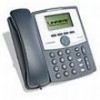Linksys SPA922 Cisco Small Business IP Phone SPA9X1 Administration Guide - Page 137
Call Back Active LED, Local Progressing LED
 |
UPC - 745883570836
View all Linksys SPA922 manuals
Add to My Manuals
Save this manual to your list of manuals |
Page 137 highlights
Phone Tab Field Remote Undefined LED Local Seized LED Remote Seized LED Local Progressing LED Remote Progressing LED Local Ringing LED Remote Ringing LED Local Active LED Remote Active LED Local Held LED Remote Held LED Register Failed LED Disabled LED Registering LED Call Back Active LED Chapter 5 Linksys IP Phone Field Reference Description LED pattern during the Remote Undefined state, where the shared call state is undefined (the station is still waiting for the state information from the application server). Not applicable if the call appearance is not shared. Leaving this entry blank indicates the default value of c=r;p=d. LED pattern during the Local Seized state, where this station has seized the call appearance to prepare for a new outbound call. Leaving this entry blank indicates the default value of c=r. LED pattern during the Remote Seized state, where the shared call appearance is seized by another station. Not application if the call appearance is not shared. Leaving this entry blank indicates the default value of c=r;p=d. LED pattern during the Local Progressing state, where this station is attempting on this call appearance an outgoing call that is in proceeding (i.e. the called number is ringing). Leaving this entry blank indicates the default value of c=r. LED pattern during the Remote Progressing state, where another station is attempting on this shared call appearance an outbound call that is progressing. Not applicable if the call appearance is not shared. Leaving this entry blank indicates the default value of c=r;p=d. LED pattern during the Local Ringing state, when the call appearance is ringing. Leaving this entry blank indicates the default value of c=r;p=f. LED pattern during the Remote Ringing state, where the shared call appearance is in ringing on another station. Not applicable if the call appearance is not shared. Leaving this entry blank indicates the default value of c=r;p=d. LED pattern during the Local Active state, where the call appearance is engaged in an active call. Leaving this entry blank indicates the default value of c=r. LED pattern during the Remote Active state, where another station is engaged in an active call on this shared call appearance. Not applicable is this call appearance is not shared. Leaving this entry blank indicates the default value of c=r;p=d. LED pattern during the Local Held state, where the call appearance is held by this station. Leaving this entry blank indicates the default value of c=r;p=s. LED pattern during the Remote Held state, where another station has placed this call appearance on hold. Not applicable if the call appearance is not shared. Leaving this entry blank indicates the default value of c=4,p=s. LED pattern when the corresponding extension has failed to register with the proxy server. Leaving this entry blank indicates the default value of c=a. LED pattern when the Call Appearance is disabled (not available for any incoming or outgoing call). Leaving this entry blank indicates the default value of c=o. LED Pattern when the corresponding extension is trying to register with the proxy server. Leaving this entry blank indicates the default value of c=r;p=s. Call Back operation is currently active on this call appearance is not shared. Leaving this entry blank indicates the default value of c=r;p=s. 5-32 Linksys IP Phone Administrator Guide Firmware Version 5.1















